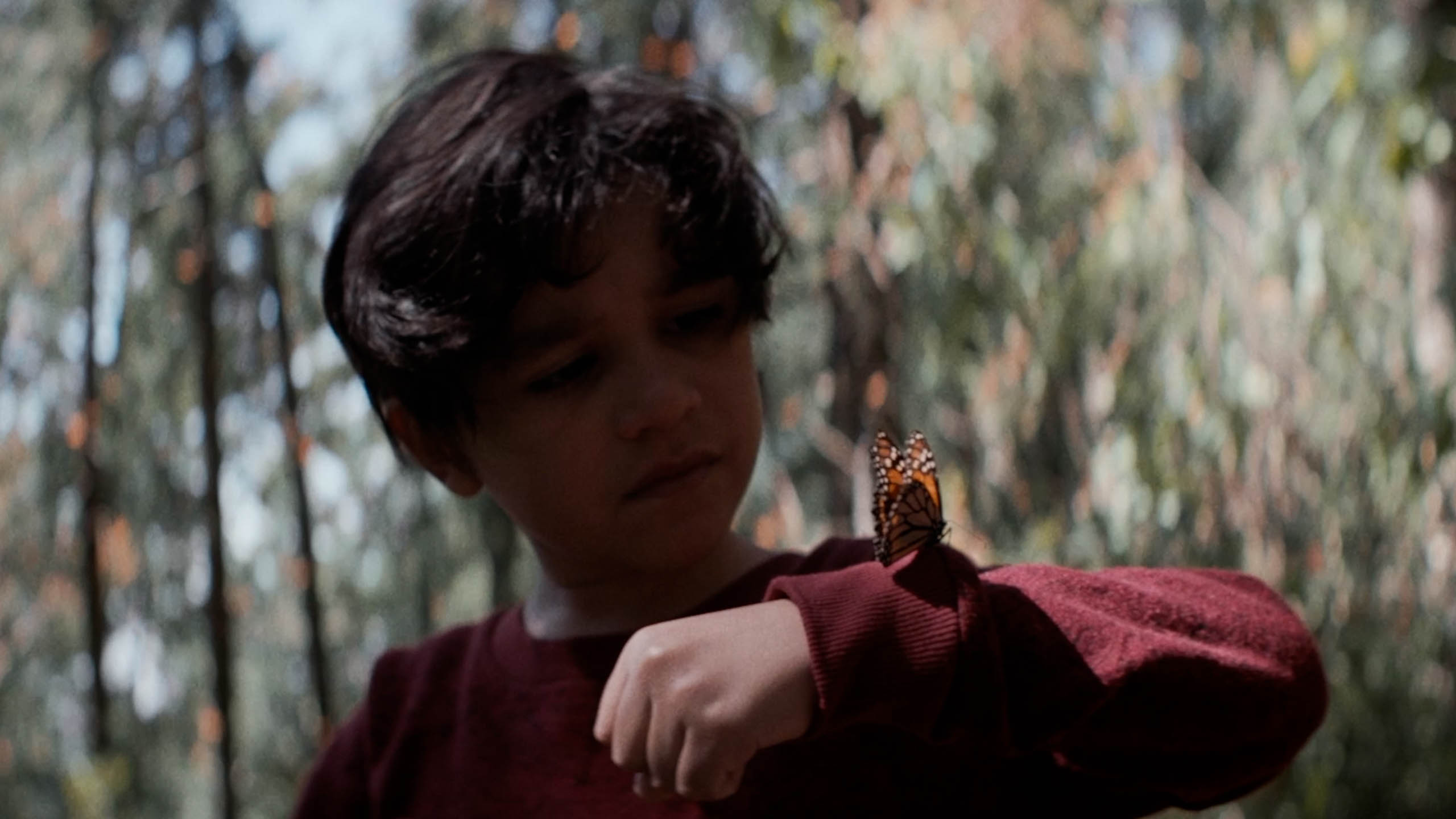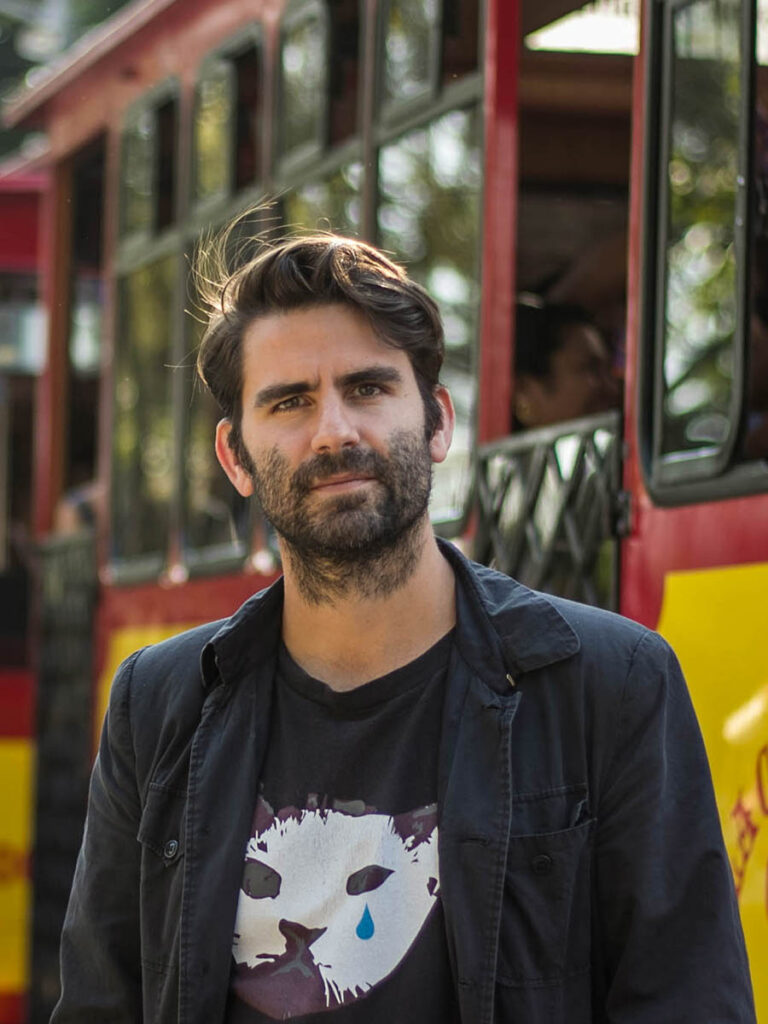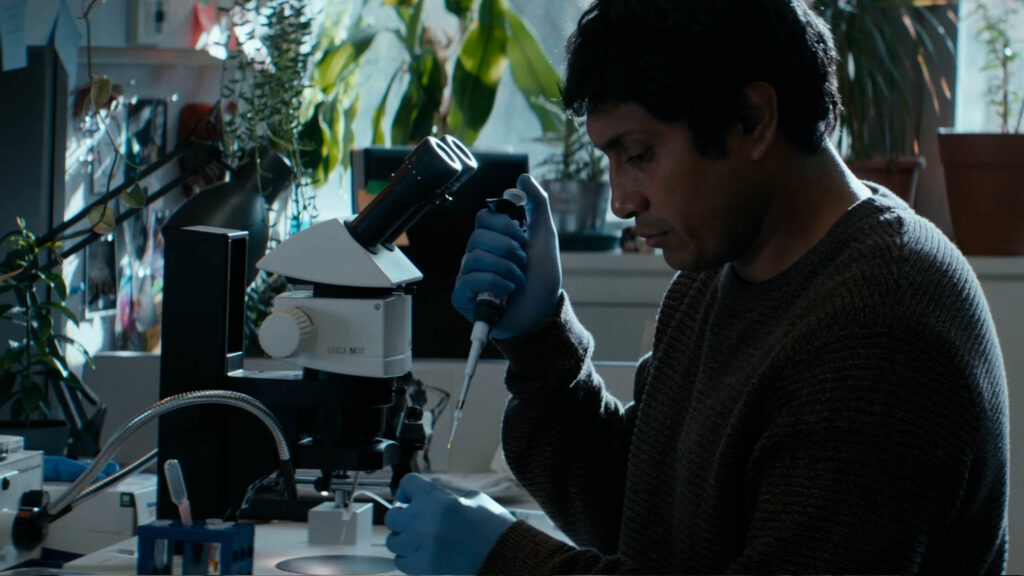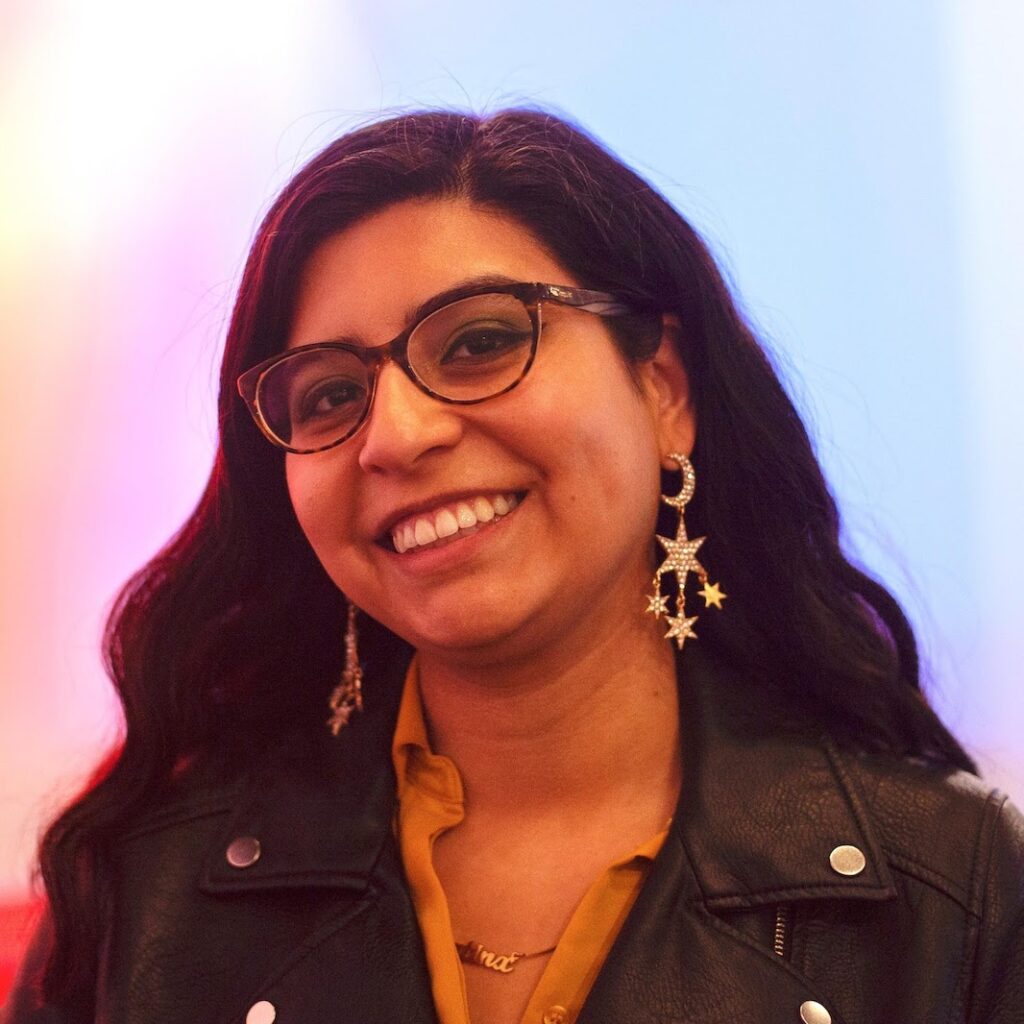
28 May From Cocoon to Butterfly: Interview with Alexis Gambis of Son of Monarchs
BY KRISTAL SOTOMAYOR
While Latinx stories and characters in cinema continue to be depicted through racist stereotypes, we take a deep dive into the films and filmmakers re-framing Latinidad through the column Cine alzando voz, meaning “Cinema raising its voice.” Through thoughtful critique and insightful interviews with Latinx artists, Cine alzando voz interrogates important issues in Latinx cinema such as queerness, womanhood, identity, immigration, and more.
Monarch butterflies have become a symbol of the immigrant rights movement, with wings that soar over borders. In the film Son of Monarchs, director Alexis Gambis weaves together the cultural significance of monarchs with the story of a Mexican biologist named Mendel (played by Tenoch Huerta Mejía). Mendel, named after geneticist Gregor Mendel, studies monarch butterflies as a biologist in New York City. When Mendel returns home to Michoacán, Mexico for his grandmother’s funeral, his rift with his brother Simon (played by Noé Hernández) has widened due to the physical distance between them. Mendel’s life centers on crossing borders between the U.S. and Mexico, much like the monarch. As Mendel studies the pigment of the butterflies, he seeks to learn more about himself, his family, and the intrinsic connection between the human and the scientific. Much like the monarch butterfly, Mendel seeks to cross over the divides among people and lands.
French Venezuelan filmmaker Alexis Gambis has a background in biology and studied genetics at Rockefeller University. His work melds together documentary and fiction filmmaking with elements of animal perspectives and scientific inquiry. He founded the Imagine Science Film Festival in 2008 with the goal of “promoting a high-level dialogue between scientists and filmmakers.” Gambis also launched the video-on-demand platform Labocine as a “hybrid platform that showcases thought-provoking and innovative science video content.” The Fly Room (2014), his first narrative feature film, is “based on the true story of the birth of modern genetics at the turn of the 20th century.”
His latest feature Son of Monarchs premiered at the 18th Festival Internacional de Cine de Morelia prior to its international premiere at the 2021 Sundance Film Festival. The film won the 2021 Alfred P. Sloan Prize at Sundance, which is awarded annually to a film centered on technology and science or that features a major character in the role of a scientist, engineer or mathematician.
Seeing Latinx scientists on the big screen or behind the camera is rare. While Son of Monarchs portrays a privileged perspective of Latinidad, one of a brilliant scientist with academic achievements, it offers a new perspective on the immigrant experience. As part of the 2021 Sundance Press Inclusion Initiative, I interviewed director Alexis Gambis during the Sundance Film Festival about re-envisioning the representation of scientists and immigrants.

Kristal Sotomayor: How did you get started with writing and directing Son of Monarchs?
Alexis Gambis: I never saw myself represented in films so [Son of Monarchs] was a little bit of a semi-biographical film, because I also ended up in New York as a scientist and trying to understand who I was. Making a film has many phases like the butterfly. It goes through different stages like the larval stage, cocoon, and then it eventually becomes a movie. I came up with the idea like eight years ago. I was really interested in exploring–through the metaphor of the butterfly–this idea of migration. I thought it would be interesting because a lot of my films tend to focus on animals as kind of a metaphor to speak about social political issues or cultural issues. I love using that metaphor of the animal. Preparing the film took about three years. I started developing the script about three or four years ago, even though I had it in the back of my mind. I went to Mexico, over two years (2017 to 2018), just interviewing. I usually start my projects by going there, making small documentaries and getting to know the people. In the US, I was interviewing scientists that worked on butterflies. All of that was informing the script I was writing. The interviews that I did fed into the characters. Like Mendel is based on a Colombian scientist that I met at Cornell.
Production was in 2019, the year before the pandemic. We were shooting in early 2019. Production is very expensive so it was done over like a month. We shot first in New York and then in Mexico. There’s a lot of pickups to do in the film because a lot of the microscope shots are things that I shoot myself, not the cinematographer. So it required me to spend time in the labs and it’s complicated because you have to put the cameras on the microscopes and you have to be very patient. It took about four years, although the idea was incubating in my mind for nine years. [I was inspired by] the previous [presidential] administration. I felt that this was a film that I had to make because it touched a lot on the families being separated from their kids at the border and issues about the wall. I kept seeing the monarch butterfly in protests and activists were using it as a symbol for migrant rights. The film seemed like a natural calling.
KS: This film shows a different side to migration through the use of the butterfly and Mendel’s life as a Mexican immigrant living and working in the U.S. How did you go about crafting this migrant story?
AG: I embrace stories about the need for a better life and the need to cross the border. I understand that those are stories that need to be told. I think there needs to be other stories about migration that are not forced migration. I really wanted to play with this idea of very fluid movements. The butterfly moves freely between the borders. Nobody tells the butterfly not to go places. It’s called to these habitats because of the cold weather, because it needs to survive [and migrate in the winter]. I wanted that to be part of the core of the film. In one scene, [Mendel’s] in Mexico and in the other scene, he’s in New York. Even in the memories everything becomes blended. As the film progresses, the back-and-forth becomes much more prominent. The worlds merged together. There’s a scene where he does a ritual in New York and he starts seeing his friends in Mexico. It’s kind of like the same camp at the same bonfire [at the ritual in Mexico]. I thought that was really important to portray.
In addition, the idea of reverse migration is prominent — this idea of going back to Mexico instead of coming to the U.S. to understand where he comes from and his roots. I’m very aware of the fact that this is a story that is of the privileged, the people that have the means to be able to come or go. In the case of Mendel, he is privileged due to academic achievement because he comes from a relatively poor, lower middle class background. I wanted that idea and I also wanted the film to be about him returning. I also wanted to leave you at the end of the film with not knowing where he was going to actually end up. Because we started in Mexico and, without giving any spoilers, we also ended in Mexico. I wanted that to be a statement that he’s returning to Mexico like the butterflies. In the broader context of migration, a story needs to be told about people going to Mexico versus Mexicans coming to the U.S. On a more kind of character-based level, I wanted there to be this sense that he belongs everywhere but he’s, like, estranged when he goes back.
I think it’s both important to speak about migration at a very kind of global thematic level, but you need to make sure that a lot of these issues are told through the character. I [could] make a big statement in the film: “the butterflies are endangered, the population has declined by 80%.” Nobody cares about butterflies but they’re the most important pollinators like bees. That wouldn’t be really that effective because it would be me kind of preaching [at the audience through the film]. But, if it’s Mendel speaking about it in passing like when Mendell said to his uncle “look at [the corporation] destroying the forest.” I think it’s much more powerful because it comes not from the filmmaker, but from an external voice.

KS: The film blends the ancestral connections with nature and technology/industry that is often ruining the ecosystem and affecting human life. Why was that ancestral connection so important to you?
AG: I wanted to speak about who are the protectors of tradition and also of the environment because tradition and spirituality [are] very linked to nature. For Mendel’s grandmother, I wanted her to almost be like a spiritual figure. She kind of appears and I didn’t want her to be too much of the story because I wanted it to be kind of like this guardian angel that really informs Mendel. We understand that he was brought up by the grandmother and also understand that he became interested in science because of all of these traditions. Mendel was a curious kid and then science also brings him back to spirituality. It’s very cyclical.
In terms of colonization–the bigger issues about the mines and the flood–it was important for me to speak about the fact [that] these issues are complex issues. It’s not as easy as saying a big industry has come and has exploited our land and our mines because, at the same time, these villages survive because of the mining industry. As Mendel’s brother said, “Who are you to come and judge us? I need to make a living. And you with your ‘pinche vida de rico’ (your rich life in the U.S.).” It is obviously not the case either because everybody has a biased view. I wanted it to be understood that it’s not that easy also to accuse. As much as I’m aware of the fact that the mining industry has been involved with deforestation and killing the butterflies, I wanted the character to embody the complexity of those issues and no better character than Mendel’s brother. Hopefully I’ve achieved this idea that it’s not that easy.
One can be an idealist and one can say, “Let’s protect these areas,” but if you talk to a local in Angangueo, Michoacána a lot of them are like, “Oh, we hope the mining industry booms again, so that we can work again.” There’s all kinds of issues, poverty, starvation and they can’t really survive from butterfly tourism, which is one of the ways in which they make a living. That’s how I kind of bring in these issues. Again, always character-driven. The grandmother is an amazing example of what she represents and that line where Mendel asks his grandmother, he says, “How old is the forest?” And she says, “A million years old.” And then he says, “How old are you?” And she says, “More or less the same.” You know, I think that kind of symbolizes who the grandmother is; she’s just in his memories and kind of the guiding force of his life.
KS: There is a quote from the film that has stuck with me: “The othering we do to humans as much as we do to nature. We believe that we live in a time where environmental and human issues cannot be separated anymore.” To me, this is the thesis of the film. Could you speak on why this idea of othering was so important for you to portray?
AG: The film is all about breaking divides and boundaries between the animal kingdom and the humans, although humans are animals; between borders; between the small and the infinite. The main idea here is that Mendel turns to the animals and especially to the monarchs for answers about how humans should be living and how they should be coexisting to create societies. There are several phases: it goes from him observing the insects, to him commenting about the legends of these insects, and then eventually he becomes the monarch. There’s also the physical shedding of divides and layers like he’s physically dissecting and opening [butterflies under the microscope] and trying to understand things. Those are some of the things that I was very conscious about. Also, the divide between science and art, the divide between identities. Identity is complex. Like I live in New York, but right now I’m in Madrid, but I’m from Venezuela, and my family’s in France. We’re all made of a mosaic of things. I think we don’t often see that in film because the film industry makes it harder to tell the stories that are cross-continental. It’s hard because of the nature of filmmaking and every country has a different way of making films and financing. I was lucky enough to be able to make the film in a relatively independent way that allowed me to be able to shoot in Mexico and New York.

KS: As you mentioned, Mendel is fascinated with butterflies and, in the end, wants to become a butterfly to the point that he gets a tattoo with butterfly ink. What is he trying to hide from or evolve into?
AG: In Mendel’s career, he studies why butterflies create the colors and the patterns that they have. He’s trying to understand the significance of color and patterns. And he even says, in a voiceover, “they have the colors and the patterns that they have because they need to protect themselves from predators.” And they also use that as a way of attracting mates for survival. The monarch butterfly has that orange color because it’s a toxic butterfly, meaning that it doesn’t have any predators. That’s why the monarch butterfly can migrate for over 3000 or 4000 miles from Toronto all the way to Mexico. The monarch doesn’t have a predator because it eats a plant called milkweed. Basically, the only animal that can eat milkweed is the monarch because it is toxic and an invasive species.
Mendel is interested in the color of the butterfly as a kid when his grandmother shows him that animals have this color. I think there’s something where he really believes that the pigment of the butterfly has like magical powers to it. I think that once Mendel understands who he is and he can break the layers of trauma that he’s going through about [his] parents dying, he has this idea like, maybe I can inject myself with this pigment to make myself more connected to the animal. It comes back to the idea of incarnate, like invoking the spirit animals and the rituals like we are animals. Of course, I love playing with this idea of science fiction or magical realism in films where you don’t really know whether or not that’s something that is feasible. I think it’s important to have hard science in the film. When I was interviewing a scientist at Cornell, I asked him “What is one of the craziest things you’ve thought of doing?” And he mentioned, “I thought about injecting butterfly pigment and creating a tattoo.” So immediately I was like, “Oh, that’s such an interesting idea.” It also allowed me to play around with this idea of him becoming a butterfly through this tattoo process.
We used a real tattoo artist. It was an amazing scene because I wanted to use a tattoo place near my house. I asked the tattoo artist “Is it possible to use butterfly pigment?” He said, “I don’t think so. But we have different types of pigments that can shine in the dark.” And I was like, “Oh, this guy’s amazing.” A lot of that scene was improvised when he started speaking about Jurassic Park. I think it also breaks the tone of the film because it’s such a meditative piece and it’s like, “Okay, now let’s get into like, a tattoo scene.”
KS: Why do you think it’s important to showcase Latinx scientists?
AG: Of course, I’m biased because I’m a biologist and filmmaker. The reason why it’s important is because it’s actually if you go to a lab today, that is how the labs are. When I was a student, a PhD student, my mentor was Mexican. Then, I had a technician that was from Istanbul and it’s all of these cultures that come together because there’s a lot of expertise that comes from abroad to the U.S. to study science. I think we also saw that a little bit with all the discussion about the vaccine, like who is behind the COVID-19 vaccine? It’s actually these like Turkish immigrants that live in Germany. There’s such a diversity in science that needs to be embraced.
I think it’s important for a young mind that is interested in science [to see diversity]. It tends to be very white male dominated in the way it’s taught and I think it’s important for them to identify and understand that this is a career that you can embark on. There are people like them that are in these fields. Also, it’s a field that is very creative. It’s not only about being in a lab but it’s very connected to an artistic process, a creative process. If you talk to scientists, they’re just fascinating people. I have friends that are molecular biologists but on the side they’re like cello players. I think it’s important for them to break the divide between science and art, which is hard because sometimes when you learn about science there are like archaic ways of being taught science.
I just think it’s really important to have, in this case, dark skinned Latinos on screen [instead of the typical portrayal of lighter skinned Latinos]. I think it’s important to have somebody like Tenoch Huerta Mejía on screen. Tenoch also said to me, “You know, I love science. I studied social sciences.” It was actually one of the roles that kind of fit him the most. We know that Tenoch has done Narcos and has played the villain. He was so excited to finally do something that he connected with and he actually really identified with the characters.
Sons of Monarchs is screening as part of the 10th Annual Philadelphia Latino Film Festival, streaming online from May 30-June 6. See what’s playing and buy festival tickets and passes here.
cinéSPEAK is a proud partner of the Philadelphia Latino Film Festival.

Kristal Sotomayor is a bilingual Latinx freelance journalist, documentary filmmaker, and festival programmer based in Philadelphia. They serve as Programming Director for the Philadelphia Latino Film Festival and Co-Founder/Journalist of ¡Presente! Media Collective. In the past, Kristal has written for ITVS, WHYY, AL DÍA, cineSPEAK and Autostraddle. They are a 2020 and 2021 Sundance Press Inclusion Initiative awardee. They are currently a member of the cinéSPEAK Editorial Collective.

Sorry, the comment form is closed at this time.